Introduction: A Star of the Dutch Golden Age
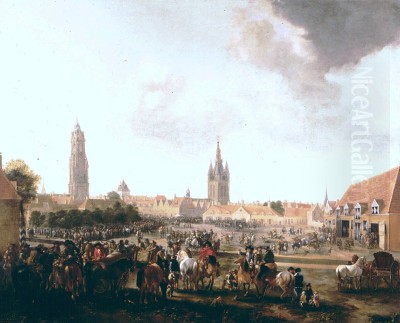
The Dutch Golden Age, spanning roughly the 17th century, was a period of extraordinary artistic flourishing in the Netherlands. Amidst giants like Rembrandt van Rijn and Johannes Vermeer, numerous highly skilled specialists carved out significant niches in the booming art market. Among the most successful and prolific of these was Philips Wouwerman (sometimes spelled Wouwermans), a painter whose name became synonymous with lively equestrian scenes, bustling military camps, elegant hunting parties, and atmospheric landscapes, often featuring his signature white horse. Born in Haarlem, a major artistic center, Wouwerman developed a distinctive style that blended meticulous Dutch realism with an Italianate sense of light and composition, achieving immense popularity during his lifetime and long after.
Philips Wouwerman was not the only artist in his family; his father, Paulus Joosten Wouwerman, was a painter, though little of his work survives. More significantly, Philips's younger brothers, Pieter Wouwerman (1623–1682) and Jan Wouwerman (1629–1666), also became painters, often working in styles similar to their more famous sibling. However, it was Philips who achieved the greatest renown, leaving behind an astonishingly large body of work that continues to fascinate viewers with its energy, detail, and technical brilliance. His ability to capture the movement of horses, the textures of fabrics, and the subtleties of light made him one of the most sought-after painters of his time.
Early Life and Artistic Formation in Haarlem
Philips Wouwerman was baptized in Haarlem on May 24, 1619. His father, Paulus Wouwerman, originally from Alkmaar, was documented as a painter, likely specializing in history painting, although no known works can be securely attributed to him today. It is highly probable that Philips received his initial artistic training from his father. Haarlem itself was a vibrant hub for artists, home to the renowned portraitist Frans Hals, the pioneering landscape painters Esaias van de Velde and Jan van Goyen, and later, the great Jacob van Ruisdael. This rich artistic environment undoubtedly played a role in Wouwerman's development.
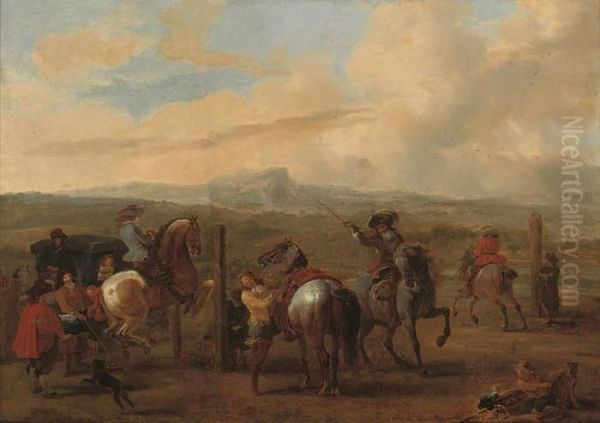
While concrete details about his apprenticeship are scarce, the early biographer Cornelis de Bie suggested Wouwerman studied with Frans Hals. Although Wouwerman's mature style shows little direct influence of Hals's bravura brushwork, a brief period in Hals's large and busy workshop is plausible, perhaps providing foundational skills. Another potential influence mentioned by early sources is Pieter Verbeeck, a Haarlem painter known for his depictions of horses, a subject that would become central to Wouwerman's own oeuvre. Learning from a specialist like Verbeeck could explain Wouwerman's early command of equine anatomy and movement.
A Journey to Hamburg and Return
A significant event in Wouwerman's early adulthood was a trip to Hamburg around 1638-1639. According to the later biographer Arnold Houbraken, Wouwerman secretly traveled there to marry Annetje Pietersz. van Brockhoff, a Catholic girl from Haarlem whom his Protestant father apparently disapproved of. While in Hamburg, Wouwerman is said to have briefly worked in the studio of Evert Decker, a German history painter whose work is now largely unknown. This journey, undertaken against paternal wishes, suggests a determined and independent streak in the young artist.
The stay in Hamburg was short-lived. By 1640, Philips Wouwerman was back in Haarlem, where he married Annetje officially and joined the Haarlem Guild of Saint Luke, the professional organization for painters and other craftsmen. Membership in the guild was essential for establishing an independent workshop and selling art legally. His entry into the guild marks the formal beginning of his professional career in his hometown, where he would remain for the rest of his life.
Establishing a Career in Haarlem
Once established back in Haarlem and admitted to the Guild of St. Luke, Philips Wouwerman's career quickly gained momentum. He became an active and respected member of the Haarlem artistic community. Records show him holding various official positions within the guild over the years, including serving as 'vinder' (an officer or agent) in 1645/46. This indicates his standing among his peers and his integration into the civic life of the city.
His workshop likely grew, possibly employing assistants or apprentices, including perhaps his own brothers Pieter and Jan at various times. He rapidly developed a reputation for his specific thematic repertoire: scenes involving horses. These ranged from depictions of stables and farriers, cavalry skirmishes and military encampments, to elegant hunting parties and riding schools. His ability to render these complex scenes with numerous figures, animals, and detailed settings appealed greatly to the tastes of the increasingly affluent Dutch burghers and international collectors. His productivity was remarkable, suggesting both a high demand for his work and an efficient studio practice.
Artistic Style: Evolution and Influences
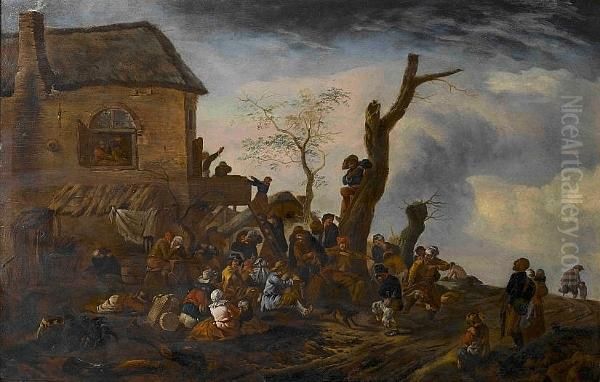
Philips Wouwerman's artistic style evolved considerably throughout his career, though certain core elements remained consistent. A key influence, particularly on his early work, was the painter Pieter van Laer, nicknamed "Il Bamboccio." Van Laer had spent time in Rome and brought back a style focused on depicting the everyday lives of peasants, soldiers, and travelers, often set in Roman or Italianate landscapes (the Bamboccianti style). Wouwerman adopted Van Laer's subject matter – stable interiors, resting travelers, humble rural scenes – but treated them with a finer technique and a cooler palette than Van Laer's often earthier tones.
Wouwerman's early paintings, roughly from the 1640s, often feature relatively simple compositions, somewhat darker colors, and a focus on genre elements. Figures tend to be robust, and the landscapes, while detailed, sometimes serve primarily as backdrops. He quickly absorbed the lessons of Dutch landscape painting, particularly the attention to atmospheric effects and naturalistic detail seen in the works of artists like Jan van Goyen, though Wouwerman's finish was always more polished.
The Middle Period: Brightness and Dynamism
By the late 1640s and into the 1650s, Wouwerman entered his mature phase, characterized by a brighter palette, more complex compositions, and an increasing emphasis on dynamic action and elegant figures. This period saw the full development of his most famous subjects: cavalry battles, hunting scenes, and military camps. His colors became clearer and cooler, often dominated by blues, silvery grays, and touches of vibrant red or yellow in the figures' costumes. The influence of Italianate landscape painters active in the Netherlands, such as Jan Both and Nicolaes Berchem, who specialized in depicting sunny, southern European scenery, becomes more apparent in the warm light and idealized settings of some works.
During this middle period, Wouwerman perfected his ability to organize large numbers of figures and horses into coherent, energetic narratives. His cavalry skirmishes are masterpieces of controlled chaos, with rearing horses, flashing swords, and billowing smoke rendered with precision. His hunting scenes capture the elegance and excitement of the chase, often set in expansive, beautifully rendered landscapes. It was also during this time that his famous white horse began to appear frequently, serving as a focal point and a signature motif.
The Late Style: Refinement and Atmosphere
In the final decade of his career, from the late 1650s until his death in 1668, Wouwerman's style reached its peak of refinement. While continuing to paint his popular themes, his technique became even more delicate, his colors often taking on a characteristic silvery or pearly tonality. His handling of light and atmosphere became exceptionally subtle, creating landscapes imbued with a sense of depth and tranquility, even when depicting lively scenes.
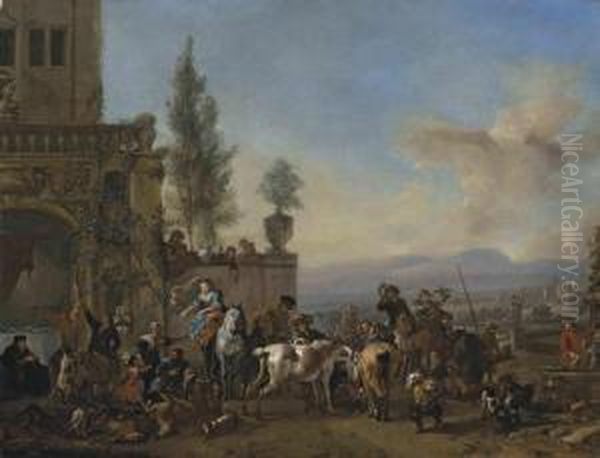
His compositions remained sophisticated, often employing diagonal recessions to lead the viewer's eye into the scene. The figures, while still meticulously detailed, sometimes became slightly more elongated and graceful. Works from this late period, such as serene landscapes with resting travelers or winter scenes with skaters, showcase his mastery of different moods and environments. Despite his relatively short life (he died just before his 49th birthday), Wouwerman maintained a remarkably high level of quality and productivity throughout his career.
Key Themes and Subjects: A World on Horseback
Philips Wouwerman's fame rests largely on his specialization in scenes involving horses, but his thematic range was broader than often assumed. His primary subjects included:
Cavalry Battles and Skirmishes: These are perhaps his most iconic works, filled with dynamic action, intricate detail, and dramatic tension. He excelled at depicting the chaos of battle while maintaining compositional clarity.
Military Camps and Halts: Wouwerman frequently painted scenes of soldiers resting, tending to their horses, gambling, or interacting with camp followers. These works offer fascinating glimpses into the military life of the period.
Hunting Parties: Often featuring elegantly dressed ladies and gentlemen on horseback accompanied by dogs, these scenes catered to aristocratic tastes and allowed Wouwerman to display his skill in rendering fine fabrics and beautiful landscapes. Stag hunts and falconry scenes were common.
Riding Schools and Stable Scenes: Demonstrating his deep understanding of equine anatomy and training, these works depict horses being schooled or cared for, often set within detailed stable interiors or outdoor arenas.
Landscapes with Travelers and Peasants: Many of Wouwerman's paintings feature travelers resting by a roadside inn, peasants working in fields, or market scenes, often incorporating horses as transport or working animals. These blend genre elements with landscape painting.
Winter Landscapes: Like many Dutch artists, Wouwerman painted evocative winter scenes, often featuring skaters on frozen canals or travelers making their way through snow-covered terrain.
Religious and Mythological Scenes: Though less common, Wouwerman occasionally painted biblical or mythological subjects, usually integrating them into landscape settings with his characteristic attention to detail.
The Signature White Horse
One cannot discuss Philips Wouwerman without mentioning his famous white or dappled grey horse. This motif appears so frequently in his paintings, particularly from his middle and late periods, that it became a virtual signature. Often placed prominently within the composition, the white horse serves as a brilliant focal point, catching the light and drawing the viewer's eye. Its recurrence led to speculation – was it a specific, favored horse? Or simply an effective compositional device?
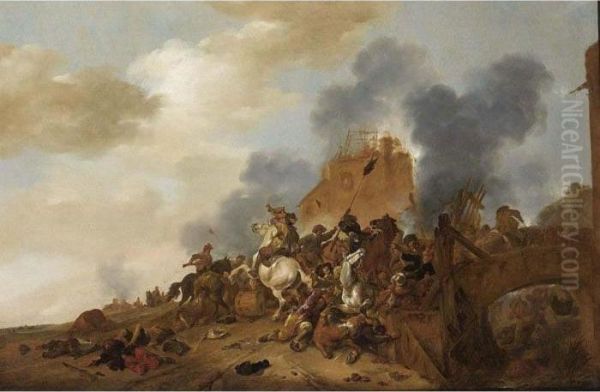
Whatever the reason, the white horse became inextricably linked with Wouwerman's name. Its presence often helps distinguish his work from that of his imitators or his brothers, although they too sometimes included similar horses. The skillful rendering of this animal, in various poses and lighting conditions, highlights Wouwerman's exceptional ability as an animal painter. It stands as a testament to his mastery in capturing the nobility and vitality of the horse.
Representative Works: A Glimpse into his Oeuvre
Given Philips Wouwerman's prolific output, estimated at anywhere between 800 and over 1,000 paintings, selecting just a few representative works is challenging. However, some well-known examples illustrate his typical themes and styles:
The White Horse (c. 1646, Rijksmuseum, Amsterdam): An iconic early-middle period work showcasing the signature motif. A man holds the reins of a magnificent white horse near a rustic dwelling, demonstrating Wouwerman's skill in animal portraiture and atmospheric landscape.
Cavalry Camp (c. 1650s, National Gallery, London): A typical military scene, bustling with activity. Soldiers rest, gamble, and tend to their horses near tents, all rendered with meticulous detail and a cool, clear light.
The Riding School (various versions, e.g., Mauritshuis, The Hague; Dulwich Picture Gallery, London): Wouwerman painted numerous variations on this theme, depicting horses being trained in outdoor arenas, showcasing his understanding of dressage and equine movement.
Stag Hunt in a River Landscape (c. 1650-55, Mauritshuis, The Hague): An example of his elegant hunting scenes, featuring finely dressed riders and hounds pursuing a stag across a river in an expansive, beautifully lit landscape.
Winter Landscape with Wooden Bridge (c. 1660s, Gemäldegalerie Alte Meister, Dresden): Demonstrates his ability to capture the specific atmosphere of winter, with figures crossing a bridge over a frozen waterway, rendered in the delicate, silvery tones of his late style.
Peasants outside an Inn (c. 1650s, National Gallery, London): Blends genre and landscape, showing travelers and peasants resting and socializing outside a country inn, a common theme treated with characteristic detail and finesse.
These examples, housed in major museums worldwide, represent only a fraction of his vast production, which can be found in collections from the Hermitage in St. Petersburg to the Louvre in Paris and countless others.
Contemporaries and Artistic Context

Philips Wouwerman worked during a period of intense artistic activity in the Netherlands. In Haarlem alone, he was contemporary with artists like Frans Hals (though Hals was much older), the landscape masters Jacob van Ruisdael and Meindert Hobbema, and the genre painter Adriaen van Ostade. While Wouwerman specialized, his work existed within this broader context. He competed in a market alongside landscape painters like Aelbert Cuyp, known for his luminous depictions of cattle in the Dutch countryside, and Paulus Potter, another renowned animal painter, though Potter's focus was more on farm animals in pastoral settings.
Wouwerman's engagement with Italianate landscape elements connects him to artists like Nicolaes Berchem, Karel Dujardin, Jan Asselijn, and Jan Both, who either traveled to Italy or adopted the warm light and picturesque scenery associated with the south. However, Wouwerman always retained a distinctly Dutch precision and narrative clarity. Compared to the dramatic intensity of Rembrandt or the quiet introspection of Vermeer, Wouwerman offered lively, detailed, and often elegant scenes that perfectly suited the tastes of the wealthy merchant class and the aristocracy both in the Netherlands and abroad. His relationship with genre painters like Jan Steen is more distant; while both depicted everyday life, Steen's focus was often on humorous or moralizing domestic scenes, whereas Wouwerman's genre elements were typically embedded within landscapes or military settings.
The Wouwerman Brothers: A Family of Painters
Philips was the most famous, but not the only, painter in the Wouwerman family. His younger brothers, Pieter (1623–1682) and Jan (1629–1666), also pursued artistic careers in Haarlem, likely training initially with their father and then heavily influenced by Philips.
Pieter Wouwerman painted similar subjects to Philips – cavalry skirmishes, hunts, landscapes with figures – often in a style that closely resembles his older brother's, leading to occasional confusion in attributions. However, Pieter's work is generally considered somewhat less refined and dynamic than Philips's best paintings. He outlived Philips by fourteen years and continued working in Haarlem.
Jan Wouwerman specialized more purely in landscape painting, often depicting simpler, more rustic scenes than his brothers. His style is characterized by a calm atmosphere and careful rendering of foliage and terrain, sometimes reminiscent of Jan Wijnants or Jacob van Ruisdael. He died relatively young, predeceasing Philips by two years. While both brothers were competent artists, neither achieved the international fame or prolific output of Philips.
Workshop Practices and Pupils
The sheer volume of Philips Wouwerman's output strongly suggests he maintained an efficient workshop, likely employing assistants or pupils to help with preparing canvases, grinding pigments, and possibly painting backgrounds or less critical areas of compositions. Identifying specific pupils is difficult, as workshop practices were not always formally documented.
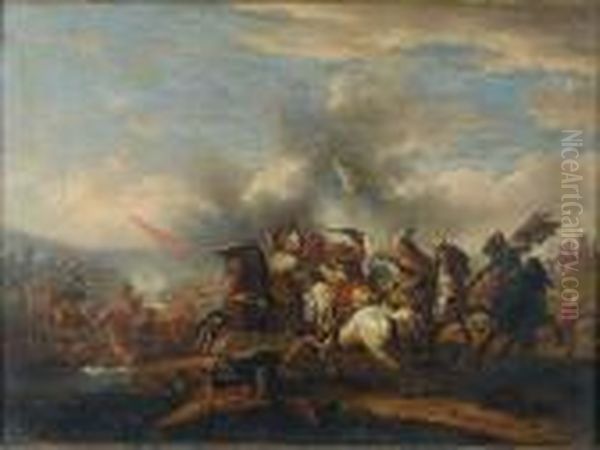
Besides his brothers, who undoubtedly learned much from him, several other artists have been suggested as pupils or close followers. Names sometimes mentioned include Nicolaes Ficke, Jacob Warnars (or Warners), and Emanuel Murant. Some sources also list Barent Gael and Cornelis Decker, though their styles differ significantly. The reality is likely that many young Haarlem artists were influenced by Wouwerman's popular style, and some may have spent time in his studio absorbing his techniques and thematic repertoire. His influence certainly extended beyond direct tutelage, shaping the market for equestrian and military scenes for decades.
Controversies and Anecdotes: The Van Laer Affair
One persistent story surrounding Philips Wouwerman, reported by Arnold Houbraken in his early 18th-century collection of artist biographies, concerns his relationship with Pieter van Laer. Houbraken claimed that Wouwerman came into possession of a portfolio of drawings and studies left behind by Van Laer after his death (or departure from Haarlem). According to this anecdote, Wouwerman used these studies extensively for his own paintings, effectively appropriating Van Laer's compositions and ideas, which supposedly contributed significantly to his own success while diminishing Van Laer's posthumous reputation.
The story culminates with the dramatic claim that Wouwerman, on his deathbed, ordered all his remaining drawings and studies to be burned, either to prevent his own heirs from becoming lazy by relying on them, or, more cynically, to destroy the evidence of his debt to Van Laer. While Van Laer's influence on Wouwerman's early work is undeniable, the tale of outright plagiarism and the burning of sketches is likely an exaggeration or fabrication, perhaps fueled by professional rivalries or misunderstandings. No contemporary evidence supports the story, and Wouwerman's own stylistic development demonstrates considerable originality beyond Van Laer's model. Nevertheless, the anecdote has colored perceptions of Wouwerman for centuries.
Legacy and Fluctuating Reputation
During his lifetime and throughout the 18th century, Philips Wouwerman was one of the most highly esteemed Dutch painters. His works commanded high prices and were eagerly sought by collectors across Europe, particularly among the aristocracy in France and Germany. His elegant subjects, refined technique, and lively compositions perfectly suited Rococo tastes. He was far more famous and expensive during this period than contemporaries like Vermeer. Major collections, such as those in Dresden, St. Petersburg (Hermitage), and Paris (Louvre), amassed large numbers of his paintings.
However, Wouwerman's reputation experienced a decline in the 19th century. Changing artistic tastes, favoring Romanticism and later Realism and Impressionism, found his work somewhat repetitive and lacking in deep emotional content. His very productivity sometimes counted against him, with critics suggesting a formulaic approach. The rise of Vermeer and Frans Hals in critical estimation also overshadowed specialists like Wouwerman.
In the 20th and 21st centuries, there has been a more balanced reassessment. While acknowledging the repetitive nature of some of his themes (driven by market demand), art historians now recognize his exceptional technical skill, his mastery of complex compositions, his subtle handling of light and atmosphere, and his significant role within the Dutch Golden Age art scene. Catalogues raisonnés, notably by Cornelis Hofstede de Groot early in the 20th century and more recently by Birgit Schumacher, have helped clarify his vast oeuvre and distinguish his work from that of his brothers and imitators. He remains a key figure for understanding the specialization and market dynamics of 17th-century Dutch art.
Conclusion: An Enduring Master of Detail and Dynamism
Philips Wouwerman stands as a testament to the depth and diversity of talent during the Dutch Golden Age. While perhaps not plumbing the psychological depths of Rembrandt or achieving the luminous stillness of Vermeer, he was an undisputed master within his chosen specializations. His ability to capture the energy of a cavalry charge, the elegance of a hunting party, or the quiet atmosphere of a landscape, all rendered with meticulous detail and technical brilliance, secured his fame for centuries.
His prolific output, his influential workshop, and the enduring appeal of his lively scenes filled with exquisitely painted horses solidify his importance. From his early works showing the influence of Pieter van Laer to the refined, silvery masterpieces of his late period, Wouwerman's career demonstrates a consistent dedication to quality and a remarkable capacity for invention within his preferred themes. He remains a captivating artist whose works offer endless details to discover and admire, providing a vivid window onto the world – particularly the equestrian world – of the 17th century.